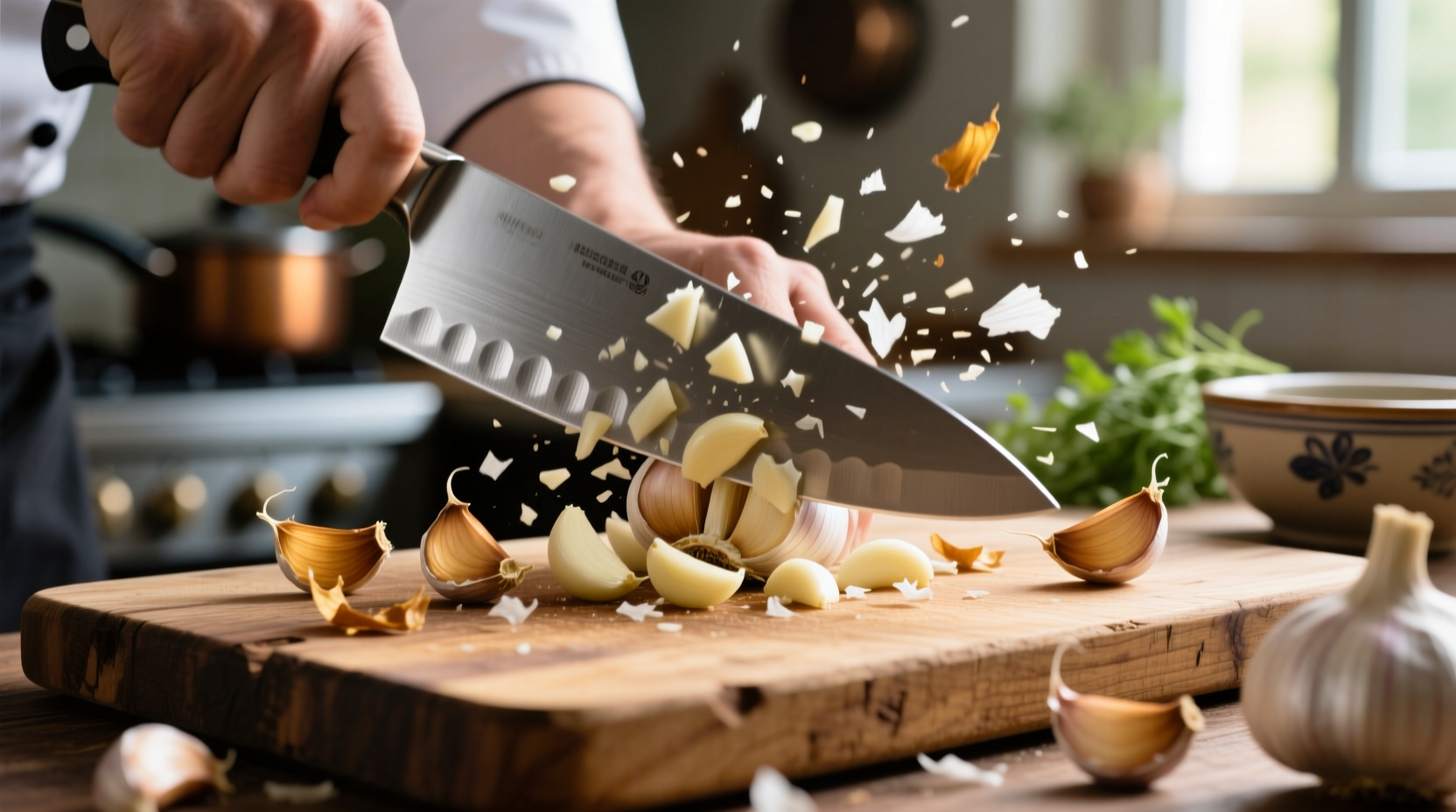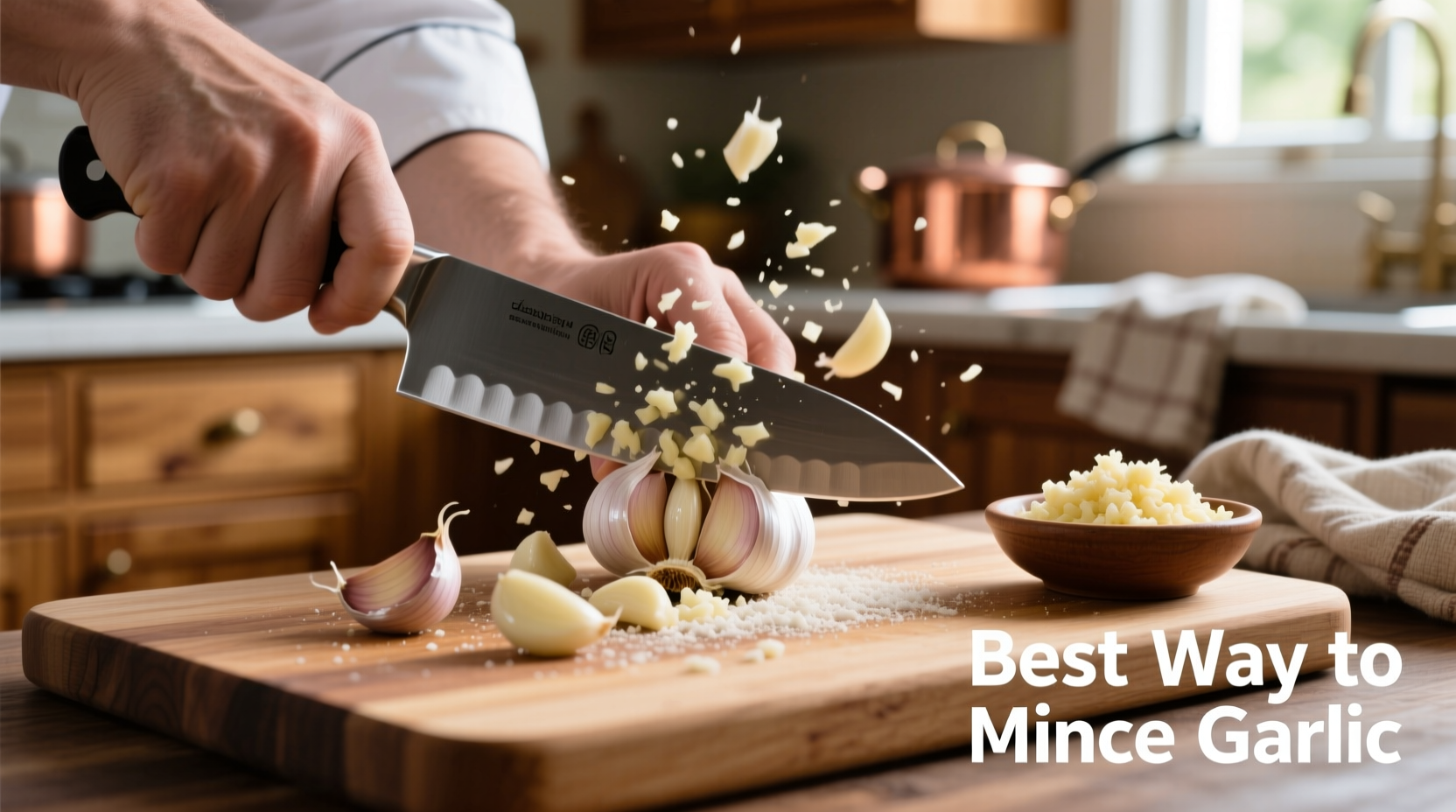Why Garlic Mincing Technique Matters More Than You Think
Garlic isn't just garlic—the way you prepare it dramatically impacts flavor, aroma, and even nutritional benefits. When you cut or crush garlic, you rupture cell walls, triggering an enzymatic reaction that creates allicin, the compound responsible for garlic's distinctive taste and health properties. But here's what most home cooks miss: different mincing techniques produce varying amounts of allicin and other flavor compounds, directly affecting your dish's final outcome.
The Science Behind Flavor Release
Garlic contains alliin and the enzyme alliinase, stored separately in intact cells. When you damage the cells through cutting or crushing, these components combine to form allicin. Research from the National Center for Biotechnology Information shows that allicin formation peaks at 30-60 seconds after cutting, then gradually degrades. Mechanical methods like presses create smaller particles that oxidize faster, producing different (sometimes bitter) compounds compared to hand-mincing.
| Mincing Method | Allicin Yield | Texture Control | Time Required | Best For |
|---|---|---|---|---|
| Knife Technique | ★★★★☆ | ★★★★★ | 2-3 minutes | Sauces, dressings, delicate dishes |
| Garlic Press | ★★★☆☆ | ★☆☆☆☆ | 30 seconds | Quick soups, stews, meat mixtures |
| Microplane | ★★★☆☆ | ★★☆☆☆ | 1 minute | Butter blends, marinades |
| Food Processor | ★★☆☆☆ | ★★★☆☆ | 2 minutes | Large batches, pesto |
Mastering the Knife Technique: Step-by-Step
Professional chefs overwhelmingly prefer the knife method for most applications. Here's how to do it properly:
- Prep the cloves: Place cloves on cutting board, lay flat side of chef's knife on top, and press firmly to loosen skin. Remove skins and any green sprouts (they cause bitterness).
- Slice thinly: Cut cloves lengthwise into thin slices—this creates more surface area for the enzymatic reaction.
- Rock chop: Gather slices, place knife tip down, and rock blade while applying gentle pressure with your free hand on the spine. Keep fingers curled safely away from blade.
- Check consistency: Stop when pieces are uniformly fine (about 1/16 inch). Over-chopping releases sulfur compounds that create bitterness.

When to Choose Alternative Methods
While the knife method generally produces superior results, certain situations call for different approaches:
- Garlic press: Ideal when you need quick incorporation into meat mixtures or when working with arthritis. Choose a press with large holes to prevent over-processing. Always peel cloves first—never use the press's peeling function as it damages cells excessively.
- Microplane: Best for infusing fats like butter or oil where you want complete integration. Works well for garlic bread or compound butters.
- Food processor: Only recommended for large batches (6+ cloves) where uniformity matters more than peak flavor. Pulse in short bursts and stop before it becomes paste.
Critical Timing Considerations
Garlic's flavor profile changes dramatically based on when you add it to your dish:
- For maximum pungency: Add minced garlic directly to cold oil and let sit 10 minutes before heating (allows full allicin development)
- For milder flavor: Add garlic to already hot oil (denatures enzymes faster)
- For best aroma: Wait 60 seconds after mincing before cooking—this is when allicin peaks according to Journal of Food Composition and Analysis research
Avoid These Common Mistakes
Even experienced cooks make these critical errors that compromise garlic's flavor:
- Using dull knives: Crushes rather than cuts cells, creating bitter compounds. Keep your chef's knife sharpened to 15-20 degree angle.
- Over-mincing: Continuing past fine texture releases polyphenol oxidase enzymes that create bitterness. Stop when pieces are uniformly small.
- Adding too early: Putting garlic in hot oil immediately causes burning before flavor develops properly.
- Not removing green sprouts: These contain bitter compounds that dominate the flavor profile.
Preserving Your Minced Garlic
If you've prepped extra garlic, proper storage maintains quality:
- Refrigerate in airtight container for up to 3 days (flavor degrades by 40% after day 2)
- Freeze in ice cube trays with olive oil for longer storage (up to 3 months)
- Never store in oil at room temperature—risk of botulism per FDA food safety guidelines
Final Recommendation
For most cooking applications, the knife technique delivers superior results with optimal flavor control. Reserve mechanical methods for specific situations where speed outweighs flavor precision. Remember that the 60-second window after mincing is critical—time your cooking steps to coincide with peak allicin development for restaurant-quality results at home. The extra minute spent perfecting your mince pays dividends in flavor complexity that mechanical methods simply can't match.
Does mincing garlic differently affect its health benefits?
Yes—proper knife mincing maximizes allicin production, which provides most of garlic's health benefits. Mechanical presses create smaller particles that oxidize faster, reducing beneficial compounds by up to 25% according to research in the Journal of Agricultural and Food Chemistry.
How fine should minced garlic actually be?
For most applications, aim for pieces about 1/16 inch (1.5mm) in size—visible but small enough to distribute evenly. Finer mincing releases bitter compounds, while larger pieces create uneven flavor distribution. The ideal texture resembles coarse sand rather than powder.
Why does my garlic sometimes turn bitter when mincing?
Bitterness occurs when you over-process garlic, releasing polyphenol oxidase enzymes. This happens most with mechanical presses and food processors. To prevent bitterness, stop mincing once pieces reach uniform fine texture, remove any green sprouts, and use a sharp knife that cuts rather than crushes the cells.
Should I let minced garlic rest before cooking?
Yes—let minced garlic rest for 60 seconds before heating. This allows maximum allicin formation, which peaks at about one minute according to food science research. Adding garlic immediately to hot oil denatures the enzymes too quickly, resulting in less complex flavor development.











 浙公网安备
33010002000092号
浙公网安备
33010002000092号 浙B2-20120091-4
浙B2-20120091-4